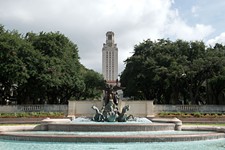Oak Hill Redevelopment: Varying visions for town center
Concept of town center node in Oak Hill looks like it's getting tougher - not easier - as city's neighborhood plan progresses
By Kimberly Reeves, Fri., June 29, 2007
The concept of a town center node in Oak Hill looks like it's getting tougher – not easier – as the city's neighborhood plan progresses.
The initial draft of Oak Hill's neighborhood plan was unveiled at an open house attended by about 100 residents Saturday. And while much of the draft plan focused on trying to balance redevelopment with environmental concerns, key neighborhood leaders are still pushing hard for a town center centered on a Capital Metro transit node.
The Oak Hill Association of Neighbor-hoods has passed not one, but two resolutions supporting rapid transit services. The messages to city planners, however, have been mixed. Some people want to keep their Hill Country lots and tranquil setting; others, like David Richardson, consider Oak Hill to be part of Austin's urban core. Richardson has spearheaded efforts to create the town center, possibly at the "Y" intersection between U.S. 290 and Highway 71. U.S. 290 bisects East and West Oak Hill.
"I think there invariably [is] going to be a difference of opinion on these things," said Richardson after the meeting. "You've got people who want nothing to change, and there are people who are frustrated with a lack of change. You've got people who have lived there for 20, 25 years and like their little part of the world, and you've got people who recognize we have become part of the urban core."
Oak Hill, by the city's definition, is not in the urban core. City Council set a 2010 deadline for neighborhood plans in the urban core. The 11,000-acre Oak Hill neighborhood was pushed to the front of the line because of its unique challenges and the impending decision from the Texas Department of Transportation on what to do to upgrade the "Y" intersection, with either a toll road or a limited-access parkway.
So consider what it will take to create this town center, given Oak Hill's location. To make this work, the city, Capital Metro, and TxDOT, along with local residents, must all agree to the town center concept. Even if private developers were interested, it would require serious negotiations over redevelopment in the drinking-water protection zone. The city wants redevelopment to match tougher water-quality standards than the existing construction on many older sites in Oak Hill.
Richardson says the Save Our Springs Ordinance has had a chilling effect on development in Oak Hill, even as development leapfrogs over Oak Hill into even more ecologically sensitive land in Hays County. He pointed out the problems in a letter to the Oak Hill Gazette: "Commercial property developed prior to SOS typically has inadequate water quality and stormwater features that allow flooding and pollution to run into Williamson Creek. Redevelopment under current land development code requires a net increase in building footprint and parking. Since redevelopment would reduce the landowners' income potential, there have been no takers. Therefore, Oak Hill is saddled with aging commercial property that serves neither neighborhoods, the business community, the environment nor the city [with tax revenue]." Richardson's answer is new development and even denser development to avoid sprawl. He also wants to create at least one city-defined major transit corridor in Oak Hill to take advantage of the city's vertical mixed-use ordinance.
City planner Maureen Meredith, who leads the city's team on the Oak Hill plan, is dealing with a lot of challenges here. Redevelopment is a real challenge in the drinking-water protection zone. Trying to create a town center, on top of that, would probably require the efforts of two planners, including one from the Economic Growth and Redevelopment Services Office. "Even from that one area, there are a lot of different visions of what a town center should be," Meredith said. "You've got some people who want 120-foot buildings, and you've got some who want only two or three stories. Some want it to be dense with buildings, and others want it spread out. The citizens' vision for the town center can vary widely."
It's hard for people like Richardson to look at other city-backed nodes – like Saltillo Plaza or Capital Metro's transit-oriented development node in Leander – and think that such a concept would not work for Oak Hill. In fact, a small coalition began meeting with leaders to explore not a bus node, but a rail spur that would drive increased density around a proposed town center. Richardson has been frustrated by what he considers a lack of responsiveness from Capital Metro. The agency simply isn't thinking big enough to make the town center concept work. Cap Met spokesman Adam Shaivitz says the Oak Hill project is still on the table but the transit agency is currently exploring its options. "The time frame is, indeed, longer than we initially anticipated due to road projects," Shaivitz said. "Enhancing our services and facilities in Oak Hill is still an important part of our planning."
The first mediation session between the Texas Department of Transportation and the Oak Hill neighborhood over Highway 290 upgrades is set for this Saturday. Carol Cespedes, leader of the community-driven Fix290 group, says the closed Saturday meeting is intended to set ground rules for the discussion. District Engineer Bob Daigh has promised options and alternatives for the project. Cespedes and her group also continue to rely on Capital Area Metropolitan Planning Organization to back their plans for a more moderate design on the proposed toll road.
Got something to say on the subject? Send a letter to the editor.









